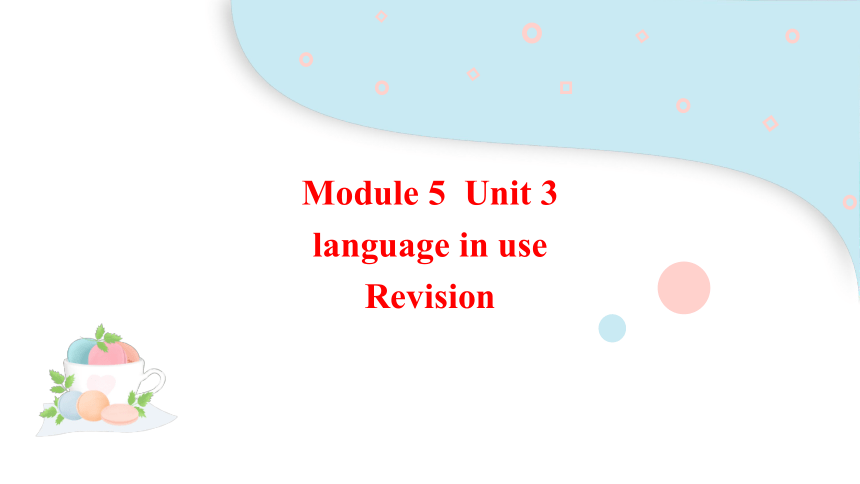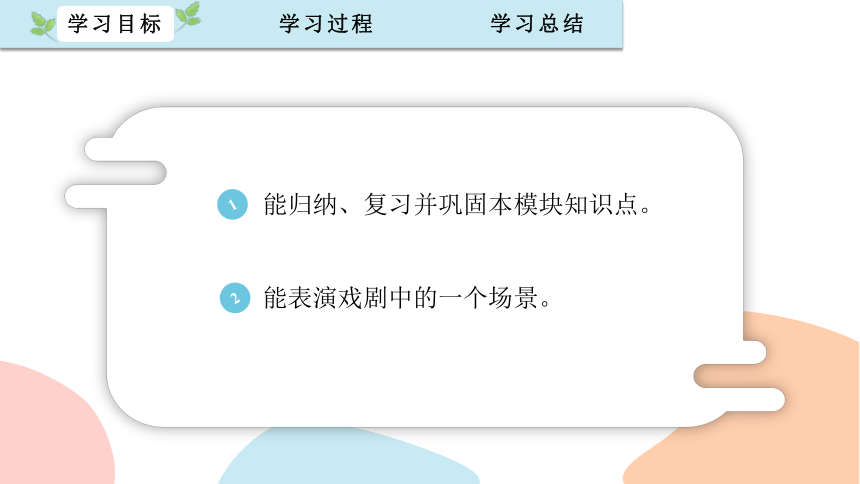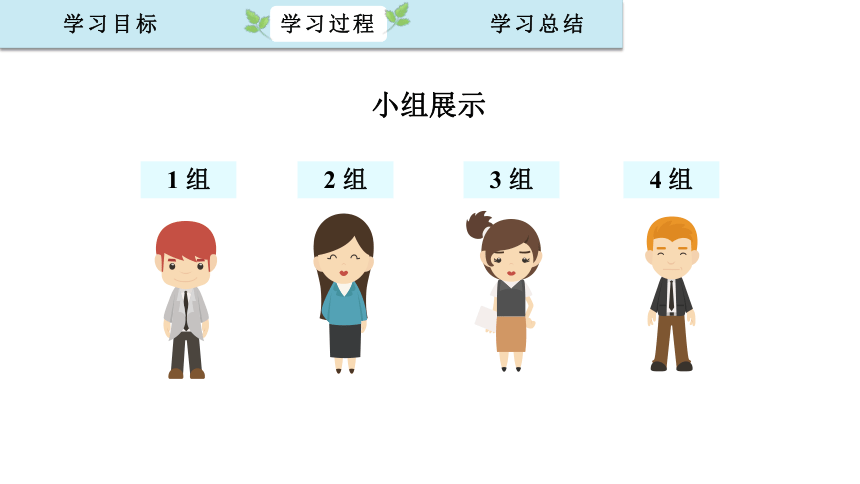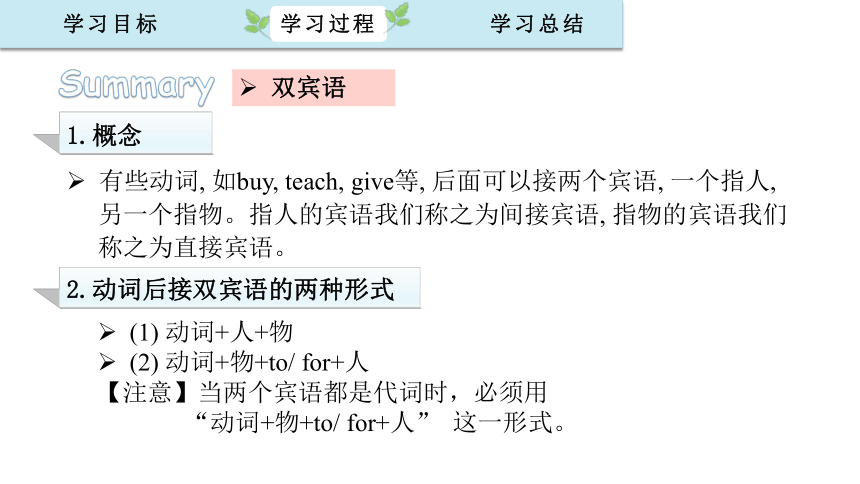Module 5 Lao She Teahouse.Unit 3 Revision 课件 (共23张PPT) 2024-2025学年英语外研版八年级上册
文档属性
| 名称 | Module 5 Lao She Teahouse.Unit 3 Revision 课件 (共23张PPT) 2024-2025学年英语外研版八年级上册 |  | |
| 格式 | pptx | ||
| 文件大小 | 25.2MB | ||
| 资源类型 | 教案 | ||
| 版本资源 | 外研版 | ||
| 科目 | 英语 | ||
| 更新时间 | 2024-07-19 20:56:29 | ||
图片预览









文档简介
(共23张PPT)
Module 5 Unit 3
language in use
Revision
1
2
能表演戏剧中的一个场景。
能归纳、复习并巩固本模块知识点。
目标一: 归纳、复习并巩固本模块知识点
Activity 1
Group Work
以小组为单位,回忆归纳:
(1) 本模块重点单词和短语有哪些?
(2) 动词不定式和双宾语的结构和用法
每个小组派一个代表发言。
1 组
2 组
3 组
4 组
小组展示
Find out the key words and phrases in this module, then share their usage or make a sentence.
Review 1
offer
would like
name
one of...
born
Example:
Could you share more
Review 2
动词不定式
1.概念
2.作用
由“不定式符号to+动词原形”构成的一种非谓语动词结构。
没有人称和数的变化,在句子中不能单独作谓语。
在句子中可以作主语、宾语、宾语补足语、定语、表语和状语等成分。
动词不定式具有动词的特点,可以有自己的宾语或补语,构成动词不定式短语。
3.常见作不定式的动词
★ 口诀记忆如下:
三个希望两答应:hope, ask, want, agree, promise
两个要求莫拒绝:demand, ask, refuse
设法学会做决定:manage, learn, decide
不要假装在选择:pretend, choose
但 finish, enjoy, miss, appreciate, mind, advise, suggest 等动词后面通常只能接动名词作宾语。
Summary
双宾语
1.概念
有些动词, 如buy, teach, give等, 后面可以接两个宾语, 一个指人,
另一个指物。指人的宾语我们称之为间接宾语, 指物的宾语我们
称之为直接宾语。
2.动词后接双宾语的两种形式
(1) 动词+人+物
(2) 动词+物+to/ for+人
【注意】当两个宾语都是代词时,必须用
“动词+物+to/ for+人” 这一形式。
3.常见的含双宾语的结构
give sb. sth. = give sth. to sb. 给某人某物
pass sb. sth. = pass sth. to sb. 把某物递给某人
show sb. sth. = show sth. to sb. 向某人展示某物
teach sb. sth. = teach sth. to sb. 把某事教给某人
lend sb. sth. = lend sth. to sb. 把某物借给某人
send sb. sth. = send sth. to sb. 把某物送给某人
cook sb. sth. = cook sth. for sb. 为某人烹饪……
make sb. sth. = make sth. for sb. 为某人做某物
buy sb. sth. = buy sth. for sb. 为某人买某物
Activity 2
4
Complete the passage with the correct form of the words
and expression in the box.
cheer magic take place theatre wonderful
We went to the (1) ________ last night to see a play. I had a (2) __________ evening. The play was very good and all the actors were excellent. The story (3) __________ in a small village in China. It was all about an old box of gold! The box was a (4) _______ box and was difficult to open. The play was very interesting, and everyone (5) _________ at the end of the play!
theatre
wonderful
took place
magic
cheered
7
Work in pairs. Talk about your weekend plans. Use
the words and expressions in the box to help you.
hope how about let’s want why don’t we why not would like
Pair Work
— I want to see the Beijing Opera.
— Why don’t we…
Now let's listen to the Vicky's plan.
5
Listen and choose the correct answer.
1. Who is visiting London
a) Vicky. b) Steve. c) Romeo.
2. What are they talking about
a) Romeo and Juliet.
b) London.
c) Vicky’s parents.
6
Listen again and check (√) the true sentences.
1. Steve went to Shakespeare’s Globe Theatre last night. ___
2. Vicky offered to take Steve to the theatre. ___
3. Steve did not try to understand the words. ___
4. Vicky hopes to see her favourite play. ___
5. Vicky thinks her parents will take her to the theatre. ___
Listen again and check your answers.
Vicky: Hello, Steve. Are you enjoying your visit to London
Steve: Thank you for asking, Vicky. I’m having a great time.
We went to Shakepear's Globe Theatre last night.
Vicky: Oh yes, it’s great. A lot of tourists want to go there.
Steve: Yes, my uncle offered to take us, and we decided to
see Romeo and Juliet.
Vicky: Did you understand the play
Steve: Well, I tried to understand the words. It was very difficult.
But I knew the story.
Vicky: I hope to see Romeo and Juliet too. It’s my favourite play.
Steve: Will your parents agree to take you
Vicky: Yes, I’m sure they will.
What play have we learned
Let's review it now with Li Ming.
8
Read the passage and choose the correct answer.
1. You would find the passage in _______.
a) a book b) a school newspaper c) a magazine
2. The writer ______.
a) liked the play b) did not like the play
c) did not say he liked the play or not
3. The actors and actresses in the play wore _____.
a) the same clothes as today b) their best clothes
c) clothes of the first half of the twentieth century
4. Li Nan is ______.
a) a famous actor b) a student c) an actress
b
a
c
b
Read the passage again and answer the questions.
1. Where the play was performed
2. Whether it was good or not
3. Why
At the theatre.
It was very good.
The actors’ and actresses’ clothes and the teahouse
furniture were right for the first half of the twentieth
century. The actors and actresses all did a very good job.
目标二:表演戏剧中的一个场景
Activity 1
What's your favorite play
Free Talk
Activity 2
Module Task: Acting out a scene from a play
Step 1: Work in groups. Find a play. Think about these questions.
1. Where does it take place
2. Who is in it
3. What is the story
4. What are the special moments in it
Step 2: Choose a scene and practise it. Then act out the scene
in front of the class.
Scene: __________________
Time: __________________________
Character: ______________________
Place: __________________________
(Note: ......)
Step 3: Act out the scene in front of the class.
Lao She's Teahouse 片段
What have you learned in Module 5
Around the world
Theatres
Western theatre started in Greece, around 600 BC. The theatres were very big. About 15,000 people could watch a play at the same time. The audience sat on stone seats to watch the performances. Some of the theatres survive, as do some of the plays by ancient Greek writers. People still watch these plays today.
Module 5 Unit 3
language in use
Revision
1
2
能表演戏剧中的一个场景。
能归纳、复习并巩固本模块知识点。
目标一: 归纳、复习并巩固本模块知识点
Activity 1
Group Work
以小组为单位,回忆归纳:
(1) 本模块重点单词和短语有哪些?
(2) 动词不定式和双宾语的结构和用法
每个小组派一个代表发言。
1 组
2 组
3 组
4 组
小组展示
Find out the key words and phrases in this module, then share their usage or make a sentence.
Review 1
offer
would like
name
one of...
born
Example:
Could you share more
Review 2
动词不定式
1.概念
2.作用
由“不定式符号to+动词原形”构成的一种非谓语动词结构。
没有人称和数的变化,在句子中不能单独作谓语。
在句子中可以作主语、宾语、宾语补足语、定语、表语和状语等成分。
动词不定式具有动词的特点,可以有自己的宾语或补语,构成动词不定式短语。
3.常见作不定式的动词
★ 口诀记忆如下:
三个希望两答应:hope, ask, want, agree, promise
两个要求莫拒绝:demand, ask, refuse
设法学会做决定:manage, learn, decide
不要假装在选择:pretend, choose
但 finish, enjoy, miss, appreciate, mind, advise, suggest 等动词后面通常只能接动名词作宾语。
Summary
双宾语
1.概念
有些动词, 如buy, teach, give等, 后面可以接两个宾语, 一个指人,
另一个指物。指人的宾语我们称之为间接宾语, 指物的宾语我们
称之为直接宾语。
2.动词后接双宾语的两种形式
(1) 动词+人+物
(2) 动词+物+to/ for+人
【注意】当两个宾语都是代词时,必须用
“动词+物+to/ for+人” 这一形式。
3.常见的含双宾语的结构
give sb. sth. = give sth. to sb. 给某人某物
pass sb. sth. = pass sth. to sb. 把某物递给某人
show sb. sth. = show sth. to sb. 向某人展示某物
teach sb. sth. = teach sth. to sb. 把某事教给某人
lend sb. sth. = lend sth. to sb. 把某物借给某人
send sb. sth. = send sth. to sb. 把某物送给某人
cook sb. sth. = cook sth. for sb. 为某人烹饪……
make sb. sth. = make sth. for sb. 为某人做某物
buy sb. sth. = buy sth. for sb. 为某人买某物
Activity 2
4
Complete the passage with the correct form of the words
and expression in the box.
cheer magic take place theatre wonderful
We went to the (1) ________ last night to see a play. I had a (2) __________ evening. The play was very good and all the actors were excellent. The story (3) __________ in a small village in China. It was all about an old box of gold! The box was a (4) _______ box and was difficult to open. The play was very interesting, and everyone (5) _________ at the end of the play!
theatre
wonderful
took place
magic
cheered
7
Work in pairs. Talk about your weekend plans. Use
the words and expressions in the box to help you.
hope how about let’s want why don’t we why not would like
Pair Work
— I want to see the Beijing Opera.
— Why don’t we…
Now let's listen to the Vicky's plan.
5
Listen and choose the correct answer.
1. Who is visiting London
a) Vicky. b) Steve. c) Romeo.
2. What are they talking about
a) Romeo and Juliet.
b) London.
c) Vicky’s parents.
6
Listen again and check (√) the true sentences.
1. Steve went to Shakespeare’s Globe Theatre last night. ___
2. Vicky offered to take Steve to the theatre. ___
3. Steve did not try to understand the words. ___
4. Vicky hopes to see her favourite play. ___
5. Vicky thinks her parents will take her to the theatre. ___
Listen again and check your answers.
Vicky: Hello, Steve. Are you enjoying your visit to London
Steve: Thank you for asking, Vicky. I’m having a great time.
We went to Shakepear's Globe Theatre last night.
Vicky: Oh yes, it’s great. A lot of tourists want to go there.
Steve: Yes, my uncle offered to take us, and we decided to
see Romeo and Juliet.
Vicky: Did you understand the play
Steve: Well, I tried to understand the words. It was very difficult.
But I knew the story.
Vicky: I hope to see Romeo and Juliet too. It’s my favourite play.
Steve: Will your parents agree to take you
Vicky: Yes, I’m sure they will.
What play have we learned
Let's review it now with Li Ming.
8
Read the passage and choose the correct answer.
1. You would find the passage in _______.
a) a book b) a school newspaper c) a magazine
2. The writer ______.
a) liked the play b) did not like the play
c) did not say he liked the play or not
3. The actors and actresses in the play wore _____.
a) the same clothes as today b) their best clothes
c) clothes of the first half of the twentieth century
4. Li Nan is ______.
a) a famous actor b) a student c) an actress
b
a
c
b
Read the passage again and answer the questions.
1. Where the play was performed
2. Whether it was good or not
3. Why
At the theatre.
It was very good.
The actors’ and actresses’ clothes and the teahouse
furniture were right for the first half of the twentieth
century. The actors and actresses all did a very good job.
目标二:表演戏剧中的一个场景
Activity 1
What's your favorite play
Free Talk
Activity 2
Module Task: Acting out a scene from a play
Step 1: Work in groups. Find a play. Think about these questions.
1. Where does it take place
2. Who is in it
3. What is the story
4. What are the special moments in it
Step 2: Choose a scene and practise it. Then act out the scene
in front of the class.
Scene: __________________
Time: __________________________
Character: ______________________
Place: __________________________
(Note: ......)
Step 3: Act out the scene in front of the class.
Lao She's Teahouse 片段
What have you learned in Module 5
Around the world
Theatres
Western theatre started in Greece, around 600 BC. The theatres were very big. About 15,000 people could watch a play at the same time. The audience sat on stone seats to watch the performances. Some of the theatres survive, as do some of the plays by ancient Greek writers. People still watch these plays today.
同课章节目录
- Module 1 How to learn English
- Unit 1 Let's try to speak English as much as possi
- Unit 2 You should smile at her.
- Unit 3 Language in use .
- Module 2 My home town and my country
- Unit 1 It's taller than many other buildings.
- Unit 2 Cambridge is a beautiful city in the east o
- Unit 3 Language in use .
- Module 3 Sports.
- Unit 1 Nothing is more exciting than playing tenni
- Unit 2 This year we training more carefully.
- Unit 3 Language in use .
- Module 4 Planes, ships and trains .
- Unit 1 He lives the farthest from school.
- Unit 2 What is the best way to travel.
- Unit 3 Language in use .
- Module 5 Lao She Teahouse.
- Unit 1 I wanted to see the Beijing Opera.
- Unit 2 It descibes the changes in Chinese society.
- Unit 3 Language in use .
- Module 6 Animals in danger.
- Unit 1 It allows people to get closer to them .
- Unit 2 The WWF is working hard to save them all.
- Unit 3 Language in use .
- Revision module A
- Module 7 A famous story
- Unit 1 Alice was sitting with her sister by the ri
- Unit 2 She was thinking about her cat.
- Unit 3 Language in use .
- Module 8 Accidents
- Unit 1 While the car were changing to red, a car s
- Unit 2 I was trying to pick it up when it bite me
- Unit 3 Language in use .
- Module 9 Population
- Unit 1 The population of China is about 1.37 billi
- Unit 2 Arnwick was a city with 200,000 people.
- Unit 3 Language in use .
- Module 10 The weathe
- Unit 1 It might snow.
- Unit 2 The weather is fine all year round.
- Unit 3 Language in use .
- Module 11 Way of life
- Unit 1 In China ,we open a gift later.
- Unit 2 In England, you usually drink tea with milk
- Unit 3 Language in use .
- Module 12 Help
- Unit 1 What should we do before help arrives?
- Unit 2 Stay away from windows and heavy furniture.
- Unit 3 Language in use .
- Revision module B
